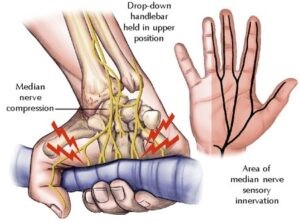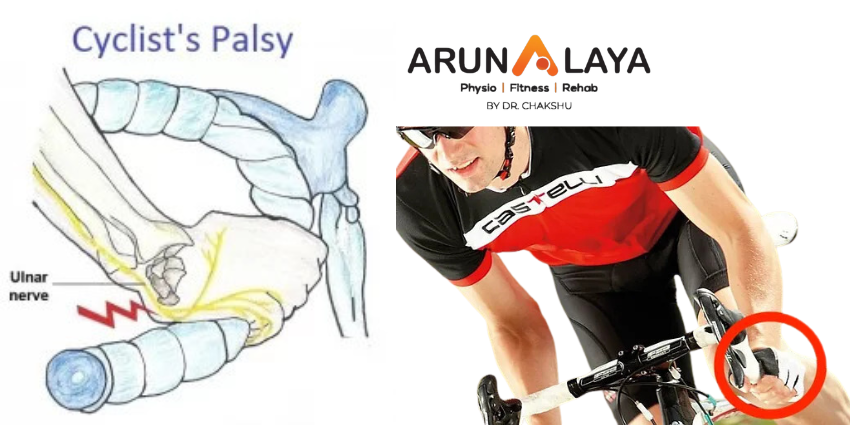Cyclist’s Palsy
Cyclist’s palsy, also known by various names such as handlebar palsy, ulnar tunnel syndrome, ulnar nerve compression, Guyon Canal Syndrome (GCS), bicycler’s neuropathy, or tardy ulnar palsy, is an overuse injury that primarily affects the hands and fingers. It occurs when the nerves in the wrist or the side of the palm near the pinky finger become compressed due to repetitive stress.
Cause of cyclist palsy
- Cyclist’s palsy can cause both motor and sensory symptoms.
- The motor symptoms can include weak hand grip and difficulty using fingers for precise tasks.
- Whereas the common sensory effects include numbness, tingling, and pain.

Although cyclist’s palsy is increasingly common, it is often underreported among cyclists. In fact, a study revealed that 7 out of 10 participants reported experiencing motor or sensory symptoms. Severe nerve injury can lead to paralysis or irreversible loss of sensation in the affected hand.
The pressure exerted on the handlebars during prolonged cycling can irritate the nerves in the palm. The highest pressure occurs where the median and ulnar nerves enter the hand, which corresponds to positions like “tops,” “ramps,” “hoods,” and “drops.” The “drops” position applies the most pressure on the ulnar nerve, while the “hoods” position applies slightly less pressure. The “tops” position places significant pressure on the palm at the base of the ring finger. The “drops” position can also cause excessive wrist extension, increasing pressure on the carpal tunnel. If a cyclist already has nerve compression at the neck or elbow, it can be more easily triggered at the palm, potentially leading to carpal tunnel syndrome or cubital tunnel syndrome.
Signs and Symptoms
- include numbness, tingling, and sensory changes in the little finger and the ring finger on the side closest to the little finger
- the palm in that area may also become numb, while there is no numbness on the back of the hand.
- The symptoms can vary depending on the location of pressure. Sometimes manifesting as numbness or weakness, or a combination of both.
- When the median nerve is affected, numbness and tingling occur on the palm side of the thumb, index, long, and ring fingers (on the side closest to the middle finger). But there is no numbness on the back of the hand.
- Prolonged or severe pressure on the nerves can also weaken the associated muscles. Some cyclists may experience pain along with hand numbness.
Treatment
Limiting cycling is the most effective treatment for cyclist’s palsies. However, there are other measures that can allow cyclists to continue their activity while reducing the risk of exacerbating the condition. These include :
- Limiting the length or distance of the ride
- Having enough rest between longer cycling sessions
- Changing positions of grip on the handlebars
- Changing to a transverse handlebar
- Adjusting the seat height
- Using gloves to reduce or distribute pressure. The pressure can be reduced with foam or gel padding in the palm of the glove.
Top 3 Cyclist Palsy Exercises
In addition to these measures, exercises play a crucial role in long-term recovery and preventing recurrence of cyclist’s palsy. These exercises primarily focus on strengthening the muscles, ligaments, and tendons in the hands. The top three recommended exercises for cyclist’s palsy are as follows:
- Finger bending exercise: Begin by stretching your hand and then bend the fingers of the affected hand at a right angle, holding them in that position for approximately 10 seconds. Ensure that your fingers remain straight during the exercise. Repeat this process five times.
- Finger squeeze: Take a small object like a coin or a sheet of paper and squeeze it between two fingers, holding the grip for 10 seconds. Repeat this exercise five times for each set of fingers.
- Grip strengthening exercise: This exercise targets a weak hand grip. Squeeze a rubber ball with the affected hand and hold for 10 seconds and then release. Repeat 10 times, and that’s one set. Aim for 3 sets of 10 as you gradually build up grip strength.

